Psoriasis- one of the most common diseases, its frequency in the population is constantly increasing every year. And if we consider that absolutely all age categories are susceptible to this pathology, and its simple forms quickly flow into more complex ones, then the question of proper therapy and prevention is really very acute.
According to statistics, about every 30 inhabitants of the planet suffer from this disease to one degree or another. What to do for those who get psoriasis? What medicines and folk remedies can be treated? How do you organize your food properly? Let's finally put all things together.
Psoriasis and its causes
Psoriasis is an autoimmune disease with a relatively vague etiology - the exact cause, although there are many studies in this area, is still unknown. It is believed that this pathology is the result of genetic changes in the immune system, as a result of which chronic inflammation of the skin develops. However, its multifactorial nature is also not excluded - in other words, involvement, co -descent, and the influence of the external environment.
It should be noted that predisposing factors, according to scientists, are very different for different age groups: for example, if various types of bacterial infections, including, in particular, streptococcal infections, are considered triggers in children, then for adults, stress stimuli andnicotine abuse is the most prevalent and alcohol, obesity, and the use of certain medications (e. g. , adrenaline receptor blockers).
It is impossible to completely cure psoriasis, however, modern medicine is quite capable of reducing the course of the disease and maintaining long -term remission in patients.
There are several theories to explain the onset of psoriasis:
- infectious and parasitic;
- neurogenic;
- endocrine;
- metabolic;
- immunology;
- from generation to generation;
- molecular imitation theory.
Like any other condition, the cause of the skin problem must be found in the gut. It is from 4 to 6 meters in length, and the inner surface is covered with villas, the width of which is comparable to the size of a tennis court - this allows the absorption process to run more efficiently. Interestingly, the cells of the small intestinal mucous membrane are completely renewed every 3-5 days. Here, moreover, up to 70% of human immunocytes are concentrated. Thus, one of the most common causes of psoriasis is considered to be leaky gut syndrome (LEPS).
Deviation from the normal function of the intestinal mucosa is fraught with malabsorption, i. e. a violation of the assimilation of basic nutrients (proteins, fats, carbohydrates, vitamins, minerals). In addition, the negative effects on the body of toxins and allergens increase: in such a situation, it is easier for them to enter the bloodstream. A direct link between psoriasis and inflammatory bowel disease has been proven in many studies.
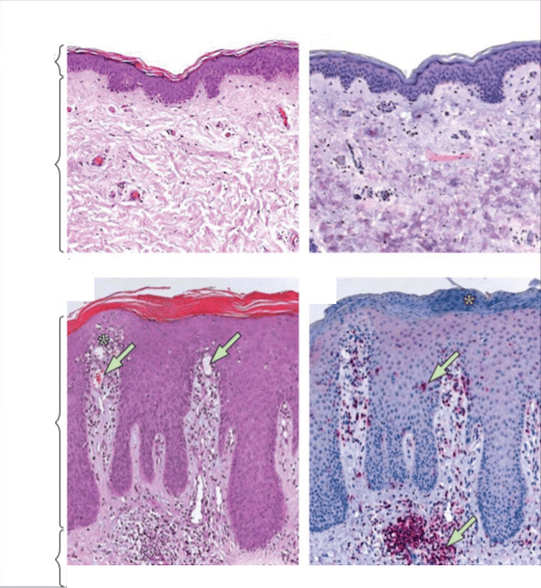
The work of other scientists confirms that a special microflora is formed on the skin of patients with psoriasis, which is significantly different from the microbiome of healthy skin.
In the area of psoriatic lesions, a mass of various bacteria is concentrated, its stability is much lower than that of normal skin - in particular, colonization by Staphylococcus aureus is observed, which has a very negative effect during the inflammatory process.
Types of psoriasis
- Psoriasis plaque. . . In 90% of cases, dermatologists are confronted with this form of the disease, also known as moderate or common. First, small detached areas appear on the skin, which are above the level of a healthy dermis. This inflamed area is called a psoriatic plaque. Gradually, they grow, merging with nearby places into one whole.
- Reverse psoriasis.This diagnosis is given to patients who experience fine red spots in the folds of the skin and in the folds - in the groin area, in the inner thighs, under the breasts. Unlike moderate psoriasis, inflammatory foci are practically not covered with scales, but because of their location and constant friction, they cause serious discomfort to the patient. In addition, there is a danger of re-infection with streptococcus or fungi, because in places where the spots are localized, due to high humidity and temperature, ideal conditions are created for the reproduction of microorganisms.
- Intestinal psoriasis.This type of disease gets its name from the form of the formation. Lesions in the form of droplets, rising above the level of healthy skin. A common trigger for this form of psoriasis is a previous streptococcal infection, as we have mentioned before. The problem is that the patient’s immunity, which is compromised while fighting infection, becomes weakened - its resources are unlimited, and, like all living things, it takes time to recover - and against this background the autoimmune disease is activated.
- Pustular psoriasis.It is considered the most severe form, accompanied by the formation of blisters filled with clear liquid. Inflammation of the skin begins around the focus, swelling and thickening appear. With secondary exacerbations, the likelihood is quite high, the blisters are filled with pus. The focus of pustular psoriasis is localized on the arms and legs. In difficult cases, there are abrasions on any part of the body, its rapid growth and the danger of infection on the entire surface of the skin.
- Psoriasis on the nails.This type of disease changes the appearance and structure of the nail plates in the hands and feet. Nails thicken, lose their natural color, emit an unpleasant odor. The skin around the nail bed is rough, thick ridges are formed. In further cases, the nail can disappear without regrowth.
- Psoriatic arthritis.In this case, the disease affects the joints and connective tissue. Often, inflammation affects the distal phalanx at the tip of the foot. There is psoriatic dactylitis - swelling of the fingers. The hip and knee joints are also vulnerable to the adverse effects of ongoing disease. There are frequent cases of disability with loss of ability to move freely.
- Psoriatic erythroderma.Fragment spots appear on the skin, while exfoliation of the affected layer is observed. The patient experienced severe discomfort due to persistent itching and swelling. Often, this diagnosis is made in patients who have been treated with moderate psoriasis, but have not completed therapy or changed medications.
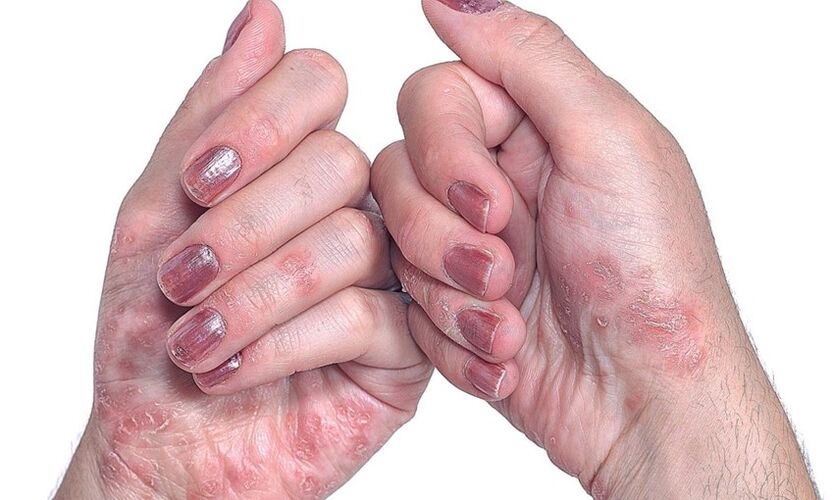
Symptoms of the disease
The first manifestation of psoriasis is a small rash on the skin. Papules grow rapidly, growing into spots with a diameter of 4 to 8 cm, they become more numerous, and dry scales form on the surface. In further cases, the individual spots merge with each other, and the lesions affect large parts of the body. Psoriatic papules can be distinguished from other skin diseases by their round shape with clear borders, red or bright pink color, and silvery white scales. They appear first in the skin area, its integrity is violated due to abrasions, wounds, frostbite, constant friction. There are three characteristic signs that confirm the onset of psoriasis development:
- Stearin spot phenomenon- dry particles are easily separated from the affected surface, showing areas that look like a drop of wax or sterol.
- Psoriatic phenomenafilm (terminal). Cleaning the papule further away from the scales allows you to see a transparent and moist film, the skin beneath it is inflamed.
- Auspitz phenomenon. . . Removal of the terminal film leads to the appearance of the smallest blood droplets on the surface of the stain.
This psoriasis triad is unique - its presence allows an accurate diagnosis to be made clearly. Even so, different parts of the body have their own characteristics regarding the manifestations of this disease.
- Psoriasis on the body.The back, neck, abdomen, thighs and lower legs are most often affected by guttate psoriasis. Small papules, which resemble the shape of drops, grow gradually, rising above the surface of the skin. This form of the disease is often diagnosed in people with staphylococcal infections.
- Psoriasis on the hands.The most common places for the appearance of psoriatic papules on the hands are the elbow and interdigital space - while, as a rule, plaque forms are observed, where small fragments of individuals merge into a single lesion area covered with dry scales. The forearms tend to be affected.
- Psoriasis of the feet.The disease begins with a single rash in the knee area. The inflamed area bothers the patient with severe exfoliation and itching, increasing in size rapidly and merging with nearby areas.
- On the palms of the hands and feet. In most cases, simultaneous defeat of both the palms and soles of the feet is noted, but in some patients the disease affects the stratum corneum on the pure upper or lower part. As a result of the growth of psoriatic papules, thickening, softening of the skin occurs with further cracking.
- Scalp psoriasis.First of all, the rash appears on the forehead, back of the head, and even behind the ears. First, the patient self -records a single scaly formation that grows, merges with nearby ones and, over time, can affect the entire scalp. Papules are very itchy, causing a constant urge to scratch the skin - the wounds and cracks produced tend to be the gateway to infection. Dry particles are separated from the destructive formation - first small, somewhat similar to dandruff, and then larger fragments.
- In the face, ears, neck.Localization of psoriatic papules on the face is somewhat excluded in the usual clinical picture. In rare cases, when this occurs, the disease affects the area around the eyes and eyelids, as well as the cheeks and tongue. The formation in the neck quickly spreads further - to the back or head. The ear is the site of development of seborrheic psoriasis. Papules can appear inside the cartilage shell and outside. When making a diagnosis, it is important not to confuse this disease with seborrheic eczema, which has similar symptoms.
- On the nails.There are three options for the early manifestations of psoriasis on the nail plate. The first is the appearance of small blood pressure. The second is the thickening of the nails, the natural color changes to gray or yellow. With further development of nail psoriasis, the plate peels off, the upper particles are easily separated. And, finally, the third is the deformation of the nail, accompanied by loss of smoothness by the plate and the appearance of stressed areas.
- Symptoms of psoriasis in children.At an early age, the disease is different: the main localization of the red scaly rash is the skin folds: inguinal, in the elbow and popliteal folds, in the neck. Papules feel itchy, children experience constant pain, irritability and restlessness. In general, all clinical variants observed in children are similar to those observed in adults. The differences concern the mere manifestation, the location of the pathological process and the course of the disease itself.
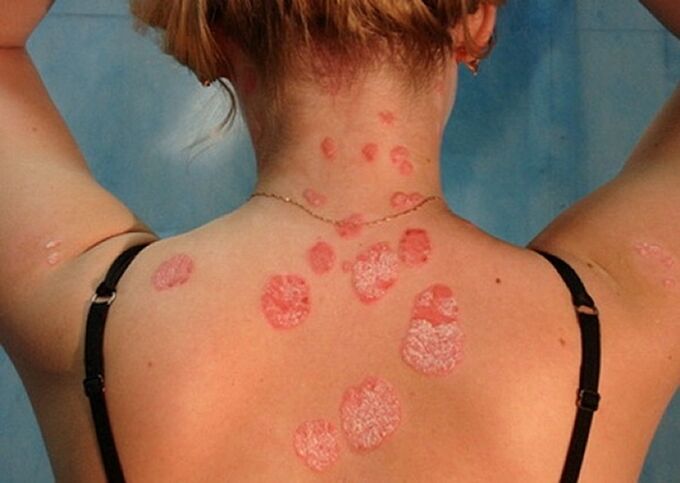

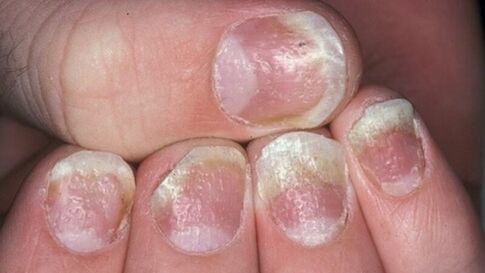
4 stages of psoriasis
Clinical dermatology, based on differences in symptoms, extent of skin lesions and their duration, distinguishes three stages of the psoriasis course. However, there is an opinion that the early stage should be recognized as another complete stage in the development of the disease.
- Early stage.The first sign of a psoriatic lesion is a small rash. The place of their appearance can vary and depends on the type of disease. Primary papules are not more than 3 mm, painted in a pale pink color, which after 3-4 days is replaced by a gray bloom - dead dermis particles are formed in place. This process is accompanied by itching and burning, and general health deteriorates. In general, the formation of plaque in the early stages takes up to three weeks, and during this time a person has the opportunity to slow the progression of pathology.
- Progressive.At this stage, the disease affects significant areas of the skin: for example, with normal psoriasis, plaques are formed, with other forms, papules are characteristic. In the process of development of the disease, individual spots merge with each other, covered with gray scales. The symptom that determines the stage of progressiveness is the Köbner phenomenon (isomorphic reaction). Any damage to the skin after a few seconds is accompanied by the appearance of a psoriatic rash in this place. Another confirmation that the disease is actively developing is the appearance of blood droplets, similar to dew, after plaque removal. The duration of this stage depends on the type of lesion. On average, it takes from two weeks to two months.
- Stationary stage.During this period, a grayish-white or thick gray crust is formed. The pink rim is missing. The skin becomes rough, dry particles constantly peel off from it. The itchy and burning sensations become unpleasant, but also do not disappear completely. New papules do not form. This stage is quite long.
- Regressive stage.The final stage of disease progression, in which there is a gradual reduction and reabsorption of plaque. Itching is no longer bothersome. The obvious sign of regression is Voronov's symptom, when the papule is surrounded by a white ring. Fading of spots occurs from the center to the edges, as a result of which strange patterns are formed on the skin. At the end of the regressive stage, only slightly different areas of skin with a healthy color are reminiscent of psoriasis. There is no need to discuss full recovery in case of psoriasis. The end of the regressive stage indicates that the disease cycle has ended, which can return at any time. In order for remission to last, it is necessary to pay attention to health: avoid provoking factors, follow a diet, be observed by a dermatologist.
Screening plans for psoriasis
- General clinical analysis of blood.
- Examining the content of vitamin D, B12, folic acid in the blood.
- Blood tests for ALT (alanine aminotransferase), AST (aspartate aminotransferase), direct bilirubin, alkaline phosphatase, gamma-glutamyl transferase, cholesterol with lipid profile, creatinine, glucose, insulin, total protein.
- Blood for rheumatoid factor, c-reactive protein, uric acid, ASLO.
- Ferritin, transferrin, serum iron are indicators of anemia (in particular, chronic diseases).
- Thyroid panel: TSH, T4 sv, TK sv.
- Coprogram.
- KhMS according to Osipov.
- Ultrasound of the abdominal organs.
Traditional treatments for psoriasis
Early therapy.
The sooner a person who discovers the early signs of a skin lesion sees a doctor, the more likely it is to take timely measures that will prevent the disease’s rapid progression and its transition to a chronic form - and, therefore, will improve overall living standards.

One of the most frequently prescribed medications at the onset of the disease is salicylic ointment. It has anti-inflammatory and antimicrobial effects, has a keratolytic effect, because the plaque is cleaned of keratin particles. To reduce itching, naphthalane ointment is also used.
Therapy at a progressive stage.
At this stage, an integrated approach to treatment is needed, and only an experienced specialist can provide it. Treatment aims to relieve symptoms, cleanse the body of toxins. To normalize metabolic processes, intramuscular injections of calcium gluconate are often prescribed. Sodium thiosulfate relieves inflammation and eliminates the manifestations of poisoning.
To moisturize inflamed skin, use special emulsions and salicylic acid. Means containing tar are contraindicated at a progressive stage: they act irritating and increase the suffering of the patient.
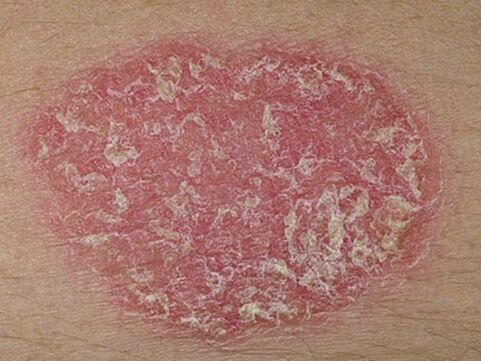
When the intensity of inflammation decreases, physiotherapy procedures can be linked. Patients with psoriasis were shown ultraviolet irradiation, PUVA therapy and paraffin application. Corticosteroids and cytostatics are not used unnecessarily, these powerful drugs are needed exclusively in difficult and advanced cases.
To reduce the manifestations of allergies, antihistamines are prescribed, and sedatives are prescribed to reduce anxiety. Diuretics help reduce swelling of inflamed skin and remove toxins from the body.
Stationary therapy.
At this stage, the inflammation fades, the plaque is covered with a dry crust, therefore, funds are needed to reduce the discomfort from the appearance of scales. This is a tar shampoo, an oil -based emulsion.
In many patients, ultraviolet irradiation and PUVA techniques have a good effect. If there is no improvement, the doctor prescribes cytostatics.
Therapy at the regressive stage.
At the end of the disease cycle, continuous correction of the method of treatment is required, depending on the current condition of the patient. Prevention is the replacement of active therapeutic action.
Patients receive recommendations to change diet and lifestyle in general. To prevent the recurrence of skin lesions, it is necessary to avoid stressful situations that trigger the formation of psoriatic plaques.
Usually, doctors give the following advice to patients:
- reconsider lifestyle: make adjustments to diet, get enough sleep, move more;
- ensure normal vitamin levelsD, iron, B vitamins, proteins in the body;
- normalize the digestive tract: excluding hypoacidity, impaired bile outflow, SIBO and CIGR (bacterial overgrowth syndrome and, consequently, fungal growth);
- get rid of the focus of chronic infection: clean the oral cavity, undergo treatment with an ENT doctor;
- dealing with concomitant somatic pathology: hypothyroidism, insulin resistance, metabolic syndrome, etc.
Traditional methods to get rid of psoriasis
- Early stage.At the first sign of skin lesions, juniper and lavender oils are effective. They soothe irritated dermis areas, promote mild wound healing, relieve congestion. A few drops of oil are added to a cream that is unbalanced in composition, for example for children, and rubbed on the rash that appears. Another popular method of dealing with the early manifestations of psoriasis is the use of 3 percent hydrogen peroxide. Any measure, even the most harmless at first glance, can be used after consultation with a dermatologist. Dietary changes, avoiding unhealthy foods and alcohol are also common recommendations of traditional healers.
- Progressive stage.At the stage of rapid development of the disease, an infusion of celandine is added to the healing oil and hydrogen peroxide. To prepare it, you need fresh and dried plant stems and brine. Alcohol tincture is contraindicated, it can worsen the condition of the affected skin. It is necessary to insist celandine for at least a few hours, and before applying the healing solution on plaque, treat it with birch tar.
- Stationary stage.At the stage of termination of the formation of new papules, you can use proven folk methods that certainly will not harm the patient. This includes the use of sulfur ointments, salicylic solutions.
- Regressive stage.In the final stages of the course of the disease, hirudotherapy (leech therapy) is often used. Although this method is not officially recognized by traditional medicine, many experts do not rule out its effectiveness. The procedure is performed within 3 - 10 days, depending on the patient's state of health.

Prevention of psoriasis: how to prevent the development of the disease
- Skincare.To reduce the possibility of psoriatic damage in the presence of genetic predisposition, simple ways to maintain skin health will help: water and hardening procedures (bathing in the sea, bathing with herbal extracts and salts, contrast baths, watering with cold water in the air, etc. ); use a soft sponge and avoid hard wipes that can damage the skin; use of detergents, natural composition, without aggressive chemical components.
- Ultraviolet rays.Several studies have proven the beneficial effects of sunlight exposure on skin prone to psoriatic plaque formation. Moderate doses of ultraviolet rays help accelerate tissue regeneration and reduce inflammation. You should not abuse sunbathing: excess rays can lead to an increase in disease.
- Clothes.Synthetic fabrics, tight styles, belts and many fasteners - all this is contraindicated for patients with psoriasis, even in trivial circumstances. Clothing must be natural, hypoallergenic, loose, not cause discomfort that can lead to a significant return of symptoms. Dark tones should be avoided for aesthetic reasons; silvery white scales are less visible on brightly colored clothing.
- Injuries.For patients with psoriasis, small cuts, scratches, abrasions can cause a return of progressive levels and secondary infections on the skin. They should be careful to avoid injury.
- Cosmetic and household products.Not all medications are suitable for maintaining hygiene for people with such a diagnosis. When choosing shower gels, soaps, shampoos, it is important to pay attention to their composition, giving preference to those that contain natural ingredients. It is better to buy a range of therapeutic treatment products sold in pharmacies. Rubbing with solid particles is completely contraindicated: they can start the disease process again due to the smallest injury to the skin. Household chemicals should also be selected based on health safety, do not use aggressive cleaning powders based on chlorine and alkali. Gloves should be worn while cleaning to avoid negative effects on the skin of the hands.
- Vitamin therapy.Maintaining a balance of vitamins is indicated for everyone, and especially for people suffering from chronic dermatitis. The complex preparation keeps the body in good condition, helps it fight viruses and prevents metabolic disorders.

Psoriasis- this is not a death sentence, but a very serious reason to reconsider the rules you have lived before. Your allies on the path of taming the disease should be competent professionals - dermatologists, nutritionists, therapists. With their help, as well as through a deliberate treatment approach, you can learn to live comfortably, even if you are already diagnosed.























